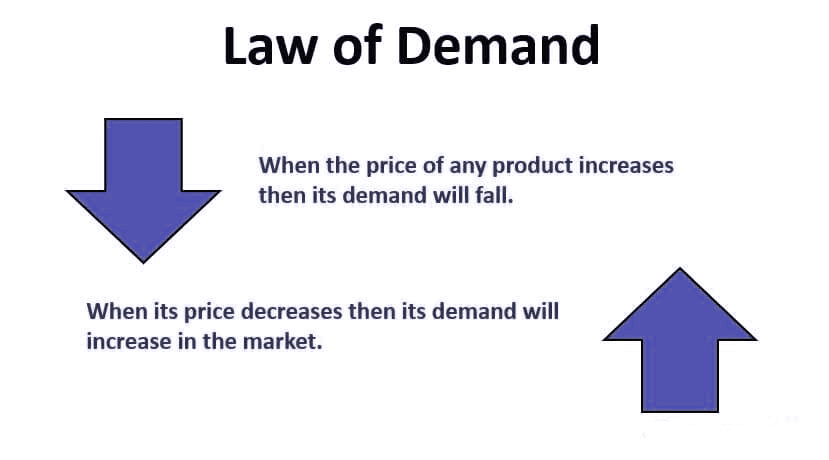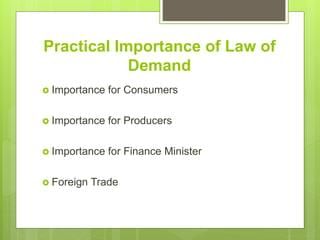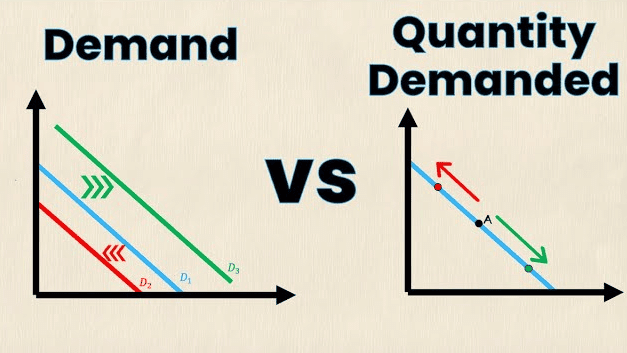Law of Demand | Crash Course for UGC NET Commerce PDF Download
Meaning of the Law of Demand

The law of demand explains that as the price of goods and services rises, the quantity demanded decreases. This relationship is depicted as a movement along the demand curve when there is a change in price. However, if there are alterations in consumer preferences or income without a price change, the entire demand curve shifts.
Charles Davenant initially articulated the law of demand in his essay titled 'Probable methods of making people gainer in the balance of trade.'
Examples of the Law of Demand
- Consider a scenario where an individual purchases two cups of coffee daily at Rs.200 each. If the price per cup rises to Rs.200, the consumer may reduce their daily consumption to only one cup. This exemplifies the law of demand, showcasing how an increase in price leads to a decrease in quantity demanded. In response to the higher coffee price, some consumers might opt for alternative beverages like tea or soft drinks, ultimately leading to a reduction in coffee consumption overall.
- Conversely, if the price of coffee drops to Rs.100, the same consumer could afford four cups per day at the same price point.
Factors Affecting Demand
- Price of Related Goods: Changes in the price of substitute goods can influence consumer behavior. For instance, if the price of coffee rises, consumers may switch to buying more tea.
- Client Income: The income level of consumers plays a crucial role in determining their demand for goods and services. A rise in income often leads to a greater demand for luxury items, while a decrease may result in a preference for more essential goods.
- Client Preferences and Tastes: Consumer preferences and trends significantly impact product demand. When a product gains popularity, its demand typically increases as more consumers opt to purchase it.
- Demographics: Factors such as age, income, population size, and education levels within a specific demographic group can affect the demand for various goods and services.
- Advertising and Marketing: Marketing strategies and advertisements can strongly influence consumer purchasing decisions. Effective advertising campaigns create awareness and can stimulate demand for particular products or services.
Importance of Law of Demand
 Understanding Consumer Behavior: The law of demand is essential for grasping how consumers behave in the market. It helps in comprehending how consumers react to price changes and how these changes affect the quantity demanded.
Understanding Consumer Behavior: The law of demand is essential for grasping how consumers behave in the market. It helps in comprehending how consumers react to price changes and how these changes affect the quantity demanded.
Example: When the price of a popular smartphone decreases, more consumers are likely to purchase it, showcasing the inverse relationship between price and demand.
Significance in Predicting Market Outcomes:
- Predicting Market Results: The law of demand aids in foreseeing market outcomes following price adjustments. It sheds light on the volume of goods sold and the competitive dynamics within the market.
- Example: If the price of a luxury car model increases significantly, the demand for that specific model might dwindle, affecting sales and market competition.
Impact on Policy Formulations:
- Government Policy Influence: Government policies, such as taxes and subsidies, directly impact product prices and consumer demand. Understanding the law of demand facilitates making informed decisions regarding policies that benefit consumers.
- Example: Implementing a tax cut on eco-friendly vehicles can stimulate demand for such cars, aligning with environmental goals while boosting consumer interest.
Enhancing Market Efficiency:
- Efficient Resource Allocation: The law of demand ensures that resources are allocated efficiently based on changes in supply and demand. It guarantees optimal utilization of goods and services in the market.
- Example: During a surge in demand for a specific product, producers adjust their supply to meet the increased consumer interest, maintaining market equilibrium.
Features of the Law of Demand
The characteristics of the law of demand can be better understood by exploring the following points.
- Inverse Relationship: In the law of demand, there exists an inverse relationship between the price of a good and the quantity demanded. When the price of a good rises, the quantity demanded tends to fall, and vice versa. For example, if the price of a popular brand of smartphones increases, consumers might opt for a more affordable alternative, leading to a decrease in the demand for the expensive brand.
- Independent-Dependent Relationship: Within this law, the price of goods is considered independent, while the quantity demanded is deemed dependent on it. This means that changes in the price of a product directly impact the quantity demanded by consumers. For instance, if the price of a certain type of coffee decreases, consumers may buy more of that coffee, resulting in an increase in demand.
- Ceteris Paribus Assumption: A fundamental aspect of studying the law of demand involves the assumption of "ceteris paribus," which means "all other things being equal." This assumption allows economists to isolate the impact of price changes on demand without the interference of other variables. For instance, when analyzing the impact of a price increase on movie tickets, economists assume that factors like consumer income and preferences remain constant.
- Temporal Limitation: The law of demand is time-bound and is typically analyzed within a specific timeframe. Economic conditions and consumer behaviors can change over time, affecting the demand for goods and services. For example, during a promotional sale period, the law of demand may be observed as consumers rush to buy discounted products, but this behavior might not persist once the sale ends.
Limitations of Law of Demand
Exploring the boundaries of the law of demand sheds light on various factors that can influence consumer behavior in ways that defy the traditional expectations of demand.
Prestige Goods:
- Prestige goods, such as diamonds and sports cars, operate as status symbols. Contrary to the typical behavior predicted by the law of demand, a decrease in their prices can actually lead to an increase in demand. This anomaly occurs because consumers often associate higher prices with exclusivity and luxury, and a reduction in price may diminish this perceived value, resulting in heightened demand.
Price Expectations:
- Consumer predictions about future price movements can influence present demand levels. If individuals anticipate a forthcoming price hike for a specific product or service, they may choose to purchase it immediately at a premium. This behavior demonstrates how expectations about price shifts can override the standard negative correlation between price and quantity demanded.
Ignorance of the Customer:
- Occasionally, consumers may lack awareness of the true worth of a product, leading them to overpay or purchase more than necessary. This ignorance can distort the typical demand-supply dynamics, as buyers make decisions based on incomplete or inaccurate information, deviating from the expected response to price changes.
Giffen Goods:
- Giffen goods, which include essential commodities like wheat, rice, and sugar, exhibit a peculiar behavior where demand decreases as prices fall and rises as prices increase. This counterintuitive pattern contradicts the conventional law of demand, as the positive relationship between price and demand challenges the usual inverse correlation.
Demand vs. Quantity Demanded

Demand:
- When we talk about "demand" in economics, we are referring to the relationship between the price of a product or service and the quantity that customers are willing and able to purchase, assuming all other factors remain constant.
- It essentially signifies the various amounts of a product or service that consumers in the market are prepared to buy at different price levels over a specific period.
- Demand is commonly illustrated as a downward-sloping demand curve on a graph, indicating that as the price of a product decreases, the quantity demanded typically goes up, and vice versa.
- Factors beyond just the price, such as consumer preferences, income levels, and the prices of related goods, can also have an impact on demand.
Quantity Demanded:
- Quantity demanded refers to the precise amount of a good or service that consumers are ready to buy at a particular price point during a specific time frame.
- It represents a single data point on the demand curve at a specific price, showcasing how much of a product consumers are willing to purchase at that price.
- The quantity demanded fluctuates with price changes, assuming all other factors influencing demand stay constant. This concept highlights how consumer behavior reacts to alterations in prices.
Conclusion
The law of demand outlines the inverse relationship between the price of goods and services and the quantity demanded by consumers over a specific period. Essentially, this law suggests that as the price of a product increases, the quantity demanded by consumers for that product tends to decrease. The law of demand is valuable for forecasting market demand and supply, as well as for analyzing how changes in prices affect the quantity demanded. Overall, the law of demand plays a crucial role in ensuring economic efficiency and the effective allocation of resources in the market.
|
214 videos|236 docs|166 tests
|
FAQs on Law of Demand - Crash Course for UGC NET Commerce
| 1. What are the key features of the Indian Contract Act 1872? |  |
| 2. What are the essentials of a valid contract according to the Indian Contract Act 1872? |  |
| 3. What are the advantages and disadvantages of human resource accounting? |  |
| 4. What is the price leadership model of oligopoly? |  |
| 5. What are the features of budgetary control? |  |





















